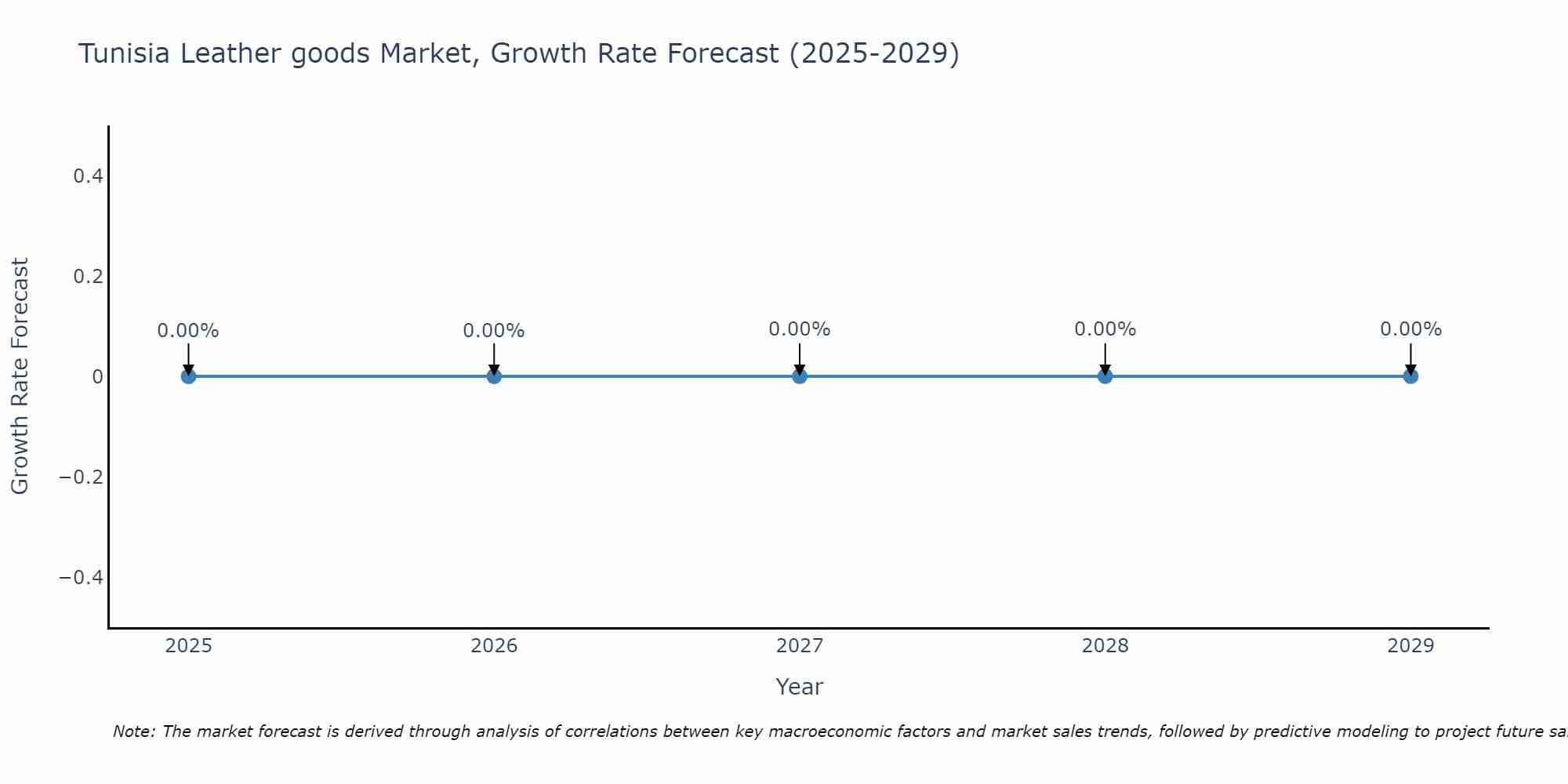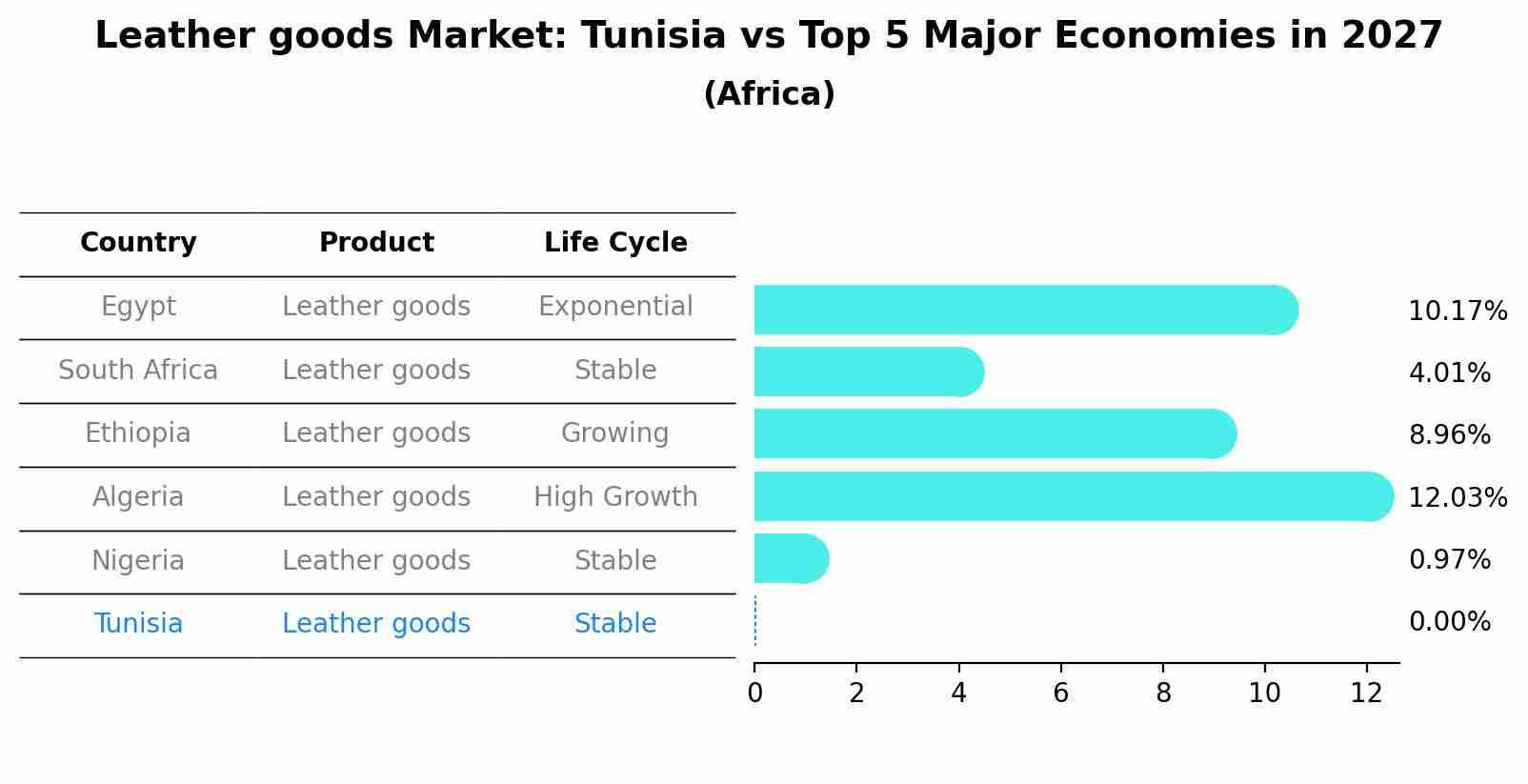Tunisia Leather goods Market (2025-2031) | Analysis, Revenue, Value, Size, Industry, COVID-19 IMPACT, Share, Companies, Growth, Outlook, Trends & Forecast
| Product Code: ETC019514 | Publication Date: Oct 2020 | Updated Date: Apr 2025 | Product Type: Report | |
| Publisher: 6Wresearch | Author: Ravi Bhandari | No. of Pages: 70 | No. of Figures: 35 | No. of Tables: 5 |
Tunisia Leather goods Market Size Growth Rate
The Tunisia Leather goods Market is poised for steady growth rate improvements from 2025 to 2029. The growth rate starts at 0.00% in 2025 and reaches 0.00% by 2029.

Leather goods Market: Tunisia vs Top 5 Major Economies in 2027 (Africa)
The Leather goods market in Tunisia is projected to grow at a stable growth rate of 0.00% by 2027, highlighting the country's increasing focus on advanced technologies within the Africa region, where Egypt holds the dominant position, followed closely by South Africa, Ethiopia, Algeria and Nigeria, shaping overall regional demand.

Tunisia Leather goods Market Overview
Tunisia`s leather goods market is witnessing growth with craftsmanship in leather handbags, wallets, and footwear, focusing on luxury, durability, and artisanal design. Market dynamics include export-oriented manufacturing, branding initiatives, and consumer preference for high-quality leather products. The market caters to fashion retailers, boutique stores, and online platforms offering bespoke and ready-to-wear leather goods to domestic and international markets.
Drivers of the market
The Tunisia leather goods market is experiencing steady growth driven by evolving fashion trends, rising disposable incomes, and increasing consumer preference for luxury and durable products. Leather goods such as handbags, wallets, and belts are not only considered status symbols but also valued for their durability and aesthetic appeal. The market is characterized by a diverse range of local artisans and international brands catering to varied consumer tastes. Furthermore, the expansion of retail channels, e-commerce platforms, and tourism-related shopping experiences are bolstering market expansion and accessibility.
Challenges of the market
The leather goods market in Tunisia faces challenges related to market saturation and competitive pressures from international brands. Local manufacturers often struggle with maintaining competitive pricing due to higher production costs and limited economies of scale compared to larger global players. Moreover, fluctuating raw material costs and supply chain disruptions impact profit margins and operational efficiency. Regulatory compliance for quality standards and environmental sustainability further adds complexity to market dynamics, influencing consumer preferences and brand positioning strategies.
Government Policy of the market
Policies encourage craftsmanship and quality standards in leather goods manufacturing, supporting artisanal traditions and promoting Tunisian leather products in global markets.
Key Highlights of the Report:
- Tunisia Leather goods Market Outlook
- Market Size of Tunisia Leather goods Market, 2024
- Forecast of Tunisia Leather goods Market, 2031
- Historical Data and Forecast of Tunisia Leather goods Revenues & Volume for the Period 2021-2031
- Tunisia Leather goods Market Trend Evolution
- Tunisia Leather goods Market Drivers and Challenges
- Tunisia Leather goods Price Trends
- Tunisia Leather goods Porter's Five Forces
- Tunisia Leather goods Industry Life Cycle
- Historical Data and Forecast of Tunisia Leather goods Market Revenues & Volume By Product Type for the Period 2021-2031
- Historical Data and Forecast of Tunisia Leather goods Market Revenues & Volume By Footwear for the Period 2021-2031
- Historical Data and Forecast of Tunisia Leather goods Market Revenues & Volume By Luggage for the Period 2021-2031
- Historical Data and Forecast of Tunisia Leather goods Market Revenues & Volume By Wallets & Purses for the Period 2021-2031
- Historical Data and Forecast of Tunisia Leather goods Market Revenues & Volume By Clothing and Apparel for the Period 2021-2031
- Historical Data and Forecast of Tunisia Leather goods Market Revenues & Volume By Others for the Period 2021-2031
- Historical Data and Forecast of Tunisia Leather goods Market Revenues & Volume By Distribution Channel for the Period 2021-2031
- Historical Data and Forecast of Tunisia Leather goods Market Revenues & Volume By Supermarkets/Hypermarkets for the Period 2021-2031
- Historical Data and Forecast of Tunisia Leather goods Market Revenues & Volume By Convenience Stores for the Period 2021-2031
- Historical Data and Forecast of Tunisia Leather goods Market Revenues & Volume By Online Stores for the Period 2021-2031
- Tunisia Leather goods Import Export Trade Statistics
- Market Opportunity Assessment By Product Type
- Market Opportunity Assessment By Distribution Channel
- Tunisia Leather goods Top Companies Market Share
- Tunisia Leather goods Competitive Benchmarking By Technical and Operational Parameters
- Tunisia Leather goods Company Profiles
- Tunisia Leather goods Key Strategic Recommendations
Frequently Asked Questions About the Market Study (FAQs):
1 Executive Summary |
2 Introduction |
2.1 Key Highlights of the Report |
2.2 Report Description |
2.3 Market Scope & Segmentation |
2.4 Research Methodology |
2.5 Assumptions |
3 Tunisia Leather goods Market Overview |
3.1 Tunisia Country Macro Economic Indicators |
3.2 Tunisia Leather goods Market Revenues & Volume, 2021 & 2031F |
3.3 Tunisia Leather goods Market - Industry Life Cycle |
3.4 Tunisia Leather goods Market - Porter's Five Forces |
3.5 Tunisia Leather goods Market Revenues & Volume Share, By Product Type, 2021 & 2031F |
3.6 Tunisia Leather goods Market Revenues & Volume Share, By Distribution Channel, 2021 & 2031F |
4 Tunisia Leather goods Market Dynamics |
4.1 Impact Analysis |
4.2 Market Drivers |
4.3 Market Restraints |
5 Tunisia Leather goods Market Trends |
6 Tunisia Leather goods Market, By Types |
6.1 Tunisia Leather goods Market, By Product Type |
6.1.1 Overview and Analysis |
6.1.2 Tunisia Leather goods Market Revenues & Volume, By Product Type, 2021-2031F |
6.1.3 Tunisia Leather goods Market Revenues & Volume, By Footwear, 2021-2031F |
6.1.4 Tunisia Leather goods Market Revenues & Volume, By Luggage, 2021-2031F |
6.1.5 Tunisia Leather goods Market Revenues & Volume, By Wallets & Purses, 2021-2031F |
6.1.6 Tunisia Leather goods Market Revenues & Volume, By Clothing and Apparel, 2021-2031F |
6.1.7 Tunisia Leather goods Market Revenues & Volume, By Others, 2021-2031F |
6.2 Tunisia Leather goods Market, By Distribution Channel |
6.2.1 Overview and Analysis |
6.2.2 Tunisia Leather goods Market Revenues & Volume, By Supermarkets/Hypermarkets, 2021-2031F |
6.2.3 Tunisia Leather goods Market Revenues & Volume, By Convenience Stores, 2021-2031F |
6.2.4 Tunisia Leather goods Market Revenues & Volume, By Online Stores, 2021-2031F |
7 Tunisia Leather goods Market Import-Export Trade Statistics |
7.1 Tunisia Leather goods Market Export to Major Countries |
7.2 Tunisia Leather goods Market Imports from Major Countries |
8 Tunisia Leather goods Market Key Performance Indicators |
9 Tunisia Leather goods Market - Opportunity Assessment |
9.1 Tunisia Leather goods Market Opportunity Assessment, By Product Type, 2021 & 2031F |
9.2 Tunisia Leather goods Market Opportunity Assessment, By Distribution Channel, 2021 & 2031F |
10 Tunisia Leather goods Market - Competitive Landscape |
10.1 Tunisia Leather goods Market Revenue Share, By Companies, 2024 |
10.2 Tunisia Leather goods Market Competitive Benchmarking, By Operating and Technical Parameters |
11 Company Profiles |
12 Recommendations |
13 Disclaimer |
- Single User License$ 1,995
- Department License$ 2,400
- Site License$ 3,120
- Global License$ 3,795
Search
Thought Leadership and Analyst Meet
Our Clients
Related Reports
- Canada Oil and Gas Market (2026-2032) | Share, Segmentation, Value, Industry, Trends, Forecast, Analysis, Size & Revenue, Growth, Competitive Landscape, Outlook, Companies
- Germany Breakfast Food Market (2026-2032) | Industry, Share, Growth, Size, Companies, Value, Analysis, Revenue, Trends, Forecast & Outlook
- Australia Briquette Market (2025-2031) | Growth, Size, Revenue, Forecast, Analysis, Trends, Value, Share, Industry & Companies
- Vietnam System Integrator Market (2025-2031) | Size, Companies, Analysis, Industry, Value, Forecast, Growth, Trends, Revenue & Share
- ASEAN and Thailand Brain Health Supplements Market (2025-2031) | Strategy, Consumer Insights, Analysis, Investment Trends, Opportunities, Growth, Size, Share, Industry, Revenue, Segments, Value, Segmentation, Supply, Forecast, Restraints, Outlook, Competition, Drivers, Trends, Demand, Pricing Analysis, Competitive, Strategic Insights, Companies, Challenges
- ASEAN Bearings Market (2025-2031) | Strategy, Consumer Insights, Analysis, Investment Trends, Opportunities, Growth, Size, Share, Industry, Revenue, Segments, Value, Segmentation, Supply, Forecast, Restraints, Outlook, Competition, Drivers, Trends, Demand, Pricing Analysis, Competitive, Strategic Insights, Companies, Challenges
- Europe Flooring Market (2025-2031) | Outlook, Share, Industry, Trends, Forecast, Companies, Revenue, Size, Analysis, Growth & Value
- Saudi Arabia Manlift Market (2025-2031) | Outlook, Size, Growth, Trends, Companies, Industry, Revenue, Value, Share, Forecast & Analysis
- Uganda Excavator, Crane, and Wheel Loaders Market (2025-2031) | Strategy, Consumer Insights, Analysis, Investment Trends, Opportunities, Growth, Size, Share, Industry, Revenue, Segments, Value, Segmentation, Supply, Forecast, Restraints, Outlook, Competition, Drivers, Trends, Demand, Pricing Analysis, Competitive, Strategic Insights, Companies, Challenges
- Rwanda Excavator, Crane, and Wheel Loaders Market (2025-2031) | Strategy, Consumer Insights, Analysis, Investment Trends, Opportunities, Growth, Size, Share, Industry, Revenue, Segments, Value, Segmentation, Supply, Forecast, Restraints, Outlook, Competition, Drivers, Trends, Demand, Pricing Analysis, Competitive, Strategic Insights, Companies, Challenges
Industry Events and Analyst Meet
Whitepaper
- Middle East & Africa Commercial Security Market Click here to view more.
- Middle East & Africa Fire Safety Systems & Equipment Market Click here to view more.
- GCC Drone Market Click here to view more.
- Middle East Lighting Fixture Market Click here to view more.
- GCC Physical & Perimeter Security Market Click here to view more.
6WResearch In News
- Doha a strategic location for EV manufacturing hub: IPA Qatar
- Demand for luxury TVs surging in the GCC, says Samsung
- Empowering Growth: The Thriving Journey of Bangladesh’s Cable Industry
- Demand for luxury TVs surging in the GCC, says Samsung
- Video call with a traditional healer? Once unthinkable, it’s now common in South Africa
- Intelligent Buildings To Smooth GCC’s Path To Net Zero


















